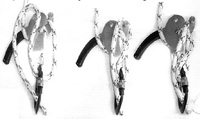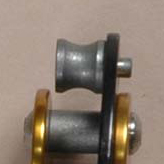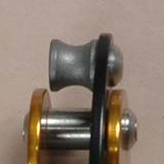Overview
Why the name changes?
SAR was using the name SCARAB at least as early as April 2006 when I received mine.
Sometime between November 16, 2007 and May 9, 2008, Conterra introduced an entirely different device and gave it the same name SCARAB. Despite SAR having been using the name for two years, Conterra registered the name, and then took legal action and forced SAR to change the name of their device.
When SAR changed the name to SARAB, I asked Dave Allport of SAR, "why the name change? Did it have anything to do with Conterra having a different descender also called the SCARAB?" Dave replied:
The name change is as you said due to Conterra registering the name for their descender. Their lawyers told us we had to change the name even though I had it first, now they seem to think that SARAB is to close and wish to sue for lost sales. They have not realized that SARAB stands for Specialist Access & Rescue Auto Brake and that the two descender's are totally different and anyone wanting theirs and finding mine would not buy it and visa versa.
Based on the dates that I acquired the SAR and Conterra SCARABS and when the SCARAB appeared on their web site, I am convinced that SAR was using the name SARAB two years before Conterra. This gives SAR priority for using the name SCARAB.
Conterra pressured SAR into another name change, and SAR chose the name SAR A•B, which probably stands for "Auto Brake."
Conterra's actions may have been legally successful, but ethically, that type of action is lower than whale dung. I have complete contempt for any who would do such a thing, and I regret having purchased the Conterra SCARAB.
[ Top
| SCARAB, Version B
| Return to Double-Stop Bobbins ]
SCARAB, Version A
(#1013)
Technical Details
 I acquired this descender from SAR in March 2006 when it first
became available.
I acquired this descender from SAR in March 2006 when it first
became available.
The front and rear plates and the handle plate are stamped
from 4.2 mm. aluminum, cut and formed to shape, and anodized.
The top portion of the plates are 20 mm. apart, but the lower
portions bend until they nearly touch, which they may under load.
The rear plate has 14.5 mm. wide by 29.5 mm. high irregular
eye. There is a 12.5 mm. diameter pin fixed near the top of the rear
side plate, and it forms the axle for the pivoting side plate. A
second, 11.5 mm. pin attached to the rear plate (34 mm.
below the first pin) supports the control lever and the lower
bollard. The pins are pressed into conical bushings on the outsides
of the plates, then planished to secure them in recesses cut into
the bushings.
The pivoting side plate has a spring-loaded, stamped, steel
gate that allows one to rig the bobbin without unclipping from
the seat harness.
The lower bollard is a 44.2 mm. diameter, 15 mm.
thick aluminum disk with a 27 mm. long flat surface on the
bottom and a 2 mm. deep U-shaped groove around the remainder
of its perimeter. It pivots on the lower pin, with the pivot axis
offset 12.5 mm. from the disc’s center. The handle pivots
on the same post as the lower bollard, fitting between the bollard
and the rear plate. The handle portion is covered with a plastic
grip for comfort. Friction from the main rope’s passage tends
to turn the lower bollard towards the upper pin, but a pin in
the rear of the bollard engages a slot in the handle, limiting
the bollards travel. The upper end of the handle plate has an
11 mm. diameter, 14.7 mm. long post pressed into it.
Serrations on the pressed section keep the post from rotating.
With the handle in the lowest position, the gap between the post
and the upper bollard is 7.2 mm.
The front of the device is printed with "SCARAB,"
the SAR logo, "Ø 10,5-12,5," "•," a book-with-an-"i" icon, "prEN12841-C," "CE-0120," a diagram showing
how to rig the SCARAB, and "ID No 05-0064" (which is
the serial number).
Normally, the load on the rope would cause the bollard to lift
the lever until the lower bollard pinches the rope against the
upper bollard, thus locking the rope and ideally arresting the
descent. The rappeller uses the handle to keep the autostop feature
disengaged. If the rappeller squeezes the lever too far, the post
on the handle moves to squeeze the rope against the upper pin,
slowing or stopping the descent. I found that it took a good grip
to move the handle enough to allow my descent. This could become
tiring on long drops. I had a similar observation for the Single Rope Technique Equipment Stop Bobbins,
and the cause was the same in both cases: squeezing the handle
actually lifts the user. Of the two, the Scarab was more comfortable.
 The
upper extension on the control arm provides a convenient place
to hang bights for locking off, as the pictures at right show.
The
upper extension on the control arm provides a convenient place
to hang bights for locking off, as the pictures at right show.
The stamped gate is well-made, but I would like to see a more
pronounced outward bend so that my thumb wouldn't slide off it
so easily when I try to open it.
The book icon makes sense, apparently SAR doesn't think that
Reading-Is-Dangerous and
chose a more sensible icon than some others have.
A small projection on the rear side of the handle looked like
an appropriate point for another one of the conical bushings.
I suspected that this was the design intent but mine somehow missed
getting one during manufacture. I wrote to Dave Allport, and he
confirmed my suspicion. Here are relevant excerpts from his note:
Thanks for the photo and I think I know
what’s happened and cannot understand how it got through the
inspection/packing. It looks as though it has not been riveted
over and into the chamfered recess in the washer.
The shaft is slightly knurled to grip
the sides of the hole then riveted over the washer. If you wish
to do the riveting there would be no problem as all that needs
doing is to place the brake bobbin onto a flat metal surface
with the rivet facing up and then planish around the edge of
the rivet with a flat faced hammer to form a slight dome so it
fills the chamfered dish in the rivet. On the other hand if you
don't feel you can or should do this I have no problems in sending
you another.
It seems this was a "one time only" oversight so
I wouldn't hold it against the Scarab.
 |
 |
| Before fix |
Normal Scarab |
[ Top
| SCARAB, Version A
| Return to Double-Stop Bobbins ]
SCARAB, Version B
(#1029)
Technical Details
 I acquired this descender from SAR in January 2007. Dave Allport
gave me this one as a replacement for Version A. This particular
Scarab was manufactured in November 2006.
I acquired this descender from SAR in January 2007. Dave Allport
gave me this one as a replacement for Version A. This particular
Scarab was manufactured in November 2006.
Version B is essentially identical to Version A.
I found the following differences.
- Obviously, there are no defects in this one.
- The upper pin is shiny stainless steel. The finish on the
one on Version A looks like the same as the finish on lower
bollard.
- The finish on the head of the lower bollard pin looks the
same as the bollard finish. The one on Version A is unfinished
stainless steel.
- The serial number marked on the front plate is "ID No
06-0272"
It was very nice of Dave to send me a replacement Scarab, and
I thank him for it. He also included a few washers so that I could
use one to repair my original one.
[ Top
| SCARAB, Version B
| Return to Double-Stop Bobbins ]
SAR SARAB
(Specialist
Access & Rescue Auto Brake)
(#1211)
Technical Details
I acquired this descender from SAR in 2009.
This SAR SARAB is 206 mm. tall, 65 mm. wide, 35 mm. thick,
and weighs 470 g. The front and rear plates and the handle plate are stamped
from 4.0 mm. aluminum, cut and formed to shape, and anodized.
The top portion of the plates are 19.6 mm. apart, but the lower
portions bend until they nearly touch, which they may under load.
The rear plate has 14 mm. wide by 29 mm. high irregular
eye. There is a 12.6 mm. diameter pin fixed near the top of the rear
side plate, and it forms the axle for the pivoting side plate. A
second, 11.5 mm. pin attached to the rear plate (35 mm.
below the first pin) supports the control lever and the lower
bollard. The pins are pressed into conical bushings on the outsides
of the plates, then planished to secure them in recesses cut into
the bushings.
The pivoting side plate has a spring-loaded, stamped, steel
gate that allows one to rig the bobbin without unclipping from
the seat harness.
The lower bollard is a 44 mm. diameter, 15 mm.
thick aluminum disk with a 27 mm. long flat surface on the
bottom and a 2 mm. deep U-shaped groove around the remainder
of its perimeter. It pivots on the lower pin, with the pivot axis
offset 12.5 mm. from the disc’s center. The handle pivots
on the same post as the lower bollard, fitting between the bollard
and the rear plate. The handle has a spring-loaded extension that
the user can unfold to provide extra leverage. Friction from the main rope’s passage tends
to turn the lower bollard towards the upper pin, but a pin in
the rear of the bollard engages a slot in the handle, limiting
the bollards travel. The upper end of the handle plate has an
15.6 mm. diameter, 14.7 mm. long post riveted into it.
The post has a 1.8 mm. deep U-shaped groove. With the handle in the lowest position, the gap between the post
and the upper bollard is 6.5 mm. A strong wire spring attached to the rear plate acts to close the handle.
The front of the device is printed with "SARAB,"
the SAR logo, "EN 12841-C," "Ø 10.5-12.5 MAX 300kg," "EN341-B," "20x100Mx100kg," "• ROPE," a book-with-an-"i" icon, "CE-0120," a diagram showing
how to rig the SCARAB, and "ID No 00073" (which is
the serial number).
The SARAB is an updated version of the SAR SCARAB. The SARAB performs much like the SCARAB, but it has two notable improvements. First, the folding handle extension provides extra leverage when needed. Second, the spring-loaded handle helps keep the SCARAB from flopping open when not in use.
I would still like to see a more
pronounced outward bend on the gate so that my thumb wouldn't slide off it
so easily when I try to open it.
[ Top
| SCARAB, Version B
| Return to Double-Stop Bobbins ]
SAR A•B
(#3202)
Technical Details
I acquired this SAR A•B from Legit Kit in 2022. My SAR A•B is 202 mm. tall, 61 mm. wide, 36 mm. thick, and weighs 455 g.
This SAR A•B is 202 mm. tall, 61 mm. wide, 35 mm. thick,
and weighs 455 g. The front and rear plates and the handle plate are stamped
from 3.9 mm. aluminum, cut and formed to shape, and anodized.
The top portion of the plates are 20.0 mm. apart, but the lower
portions bend until they nearly touch, which they may under load.
The rear plate has 14 mm. wide by 29 mm. high irregular
eye. There is a 12.6 mm. diameter pin fixed near the top of the rear
side plate, and it forms the axle for the pivoting side plate. A
second, 11.0 mm. pin attached to the rear plate (34 mm.
below the first pin) supports the control lever and the lower
bollard. The pins are pressed into conical bushings on the outsides
of the plates, then planished to secure them in recesses cut into
the bushings.
The pivoting side plate has a spring-loaded, stamped, steel
gate that allows one to rig the bobbin without unclipping from
the seat harness.
The lower bollard is a 44 mm. diameter, 15 mm.
thick aluminum disk with a 27 mm. long flat surface on the
bottom and a 2 mm. deep U-shaped groove around the remainder
of its perimeter. It pivots on the lower pin, with the pivot axis
offset 12.5 mm. from the disc’s center.
The handle pivots
on the same post as the lower bollard, fitting between the bollard
and the rear plate. The handle has a spring-loaded extension that
the user can unfold to provide extra leverage. Friction from the main rope’s passage tends
to turn the lower bollard towards the upper pin until the handle contact the upper bollard.
The upper end of the handle plate has an
15.9 mm. diameter, 14.7 mm. long post riveted into it.The post has a 1.8 mm. deep U-shaped groove.
The outer end of the post has a 21.5 mm. flange. With the handle in the lowest position, the gap between the post
and the upper bollard is 6.5 mm. A strong, hidden wire spring acts to close the handle.
The front of the device is printed with
the SAR logo, "A•B Descender," "Made in UK," "EN 12841-C," "Ø 10.5-12.5 MAX 300kg," "EN341-B," "20x100Mx100kg," "• ROPE," a book-with-an-"i" icon, "CE-0120," a diagram showing
how to rig the SCARAB, and "14/002106."
The SAR A•B is an updated version of the SARAB. The major differences are as follows:
- The SARAB has an external handle spring, while the IA•B handle spring is hidden.
- The top post on the A•B has a much larger flange than the one on the SARAB.
- The lower bollard on the A•B is smaller than the one on the SARAB.
- The axle pin bollard on the SARAB is stainless steel, while the one on the A•B is aluminum.
The bent tab on the gate is still sloped and my thumb still slides off too easily when I try to open it.
The ISC A•B is essentially the same device.
[ Top
| SCARAB, Version A
| SCARAB, Version B
| SARABB
| SARABB
]




 The
upper extension on the control arm provides a convenient place
to hang bights for locking off, as the pictures at right show.
The
upper extension on the control arm provides a convenient place
to hang bights for locking off, as the pictures at right show.